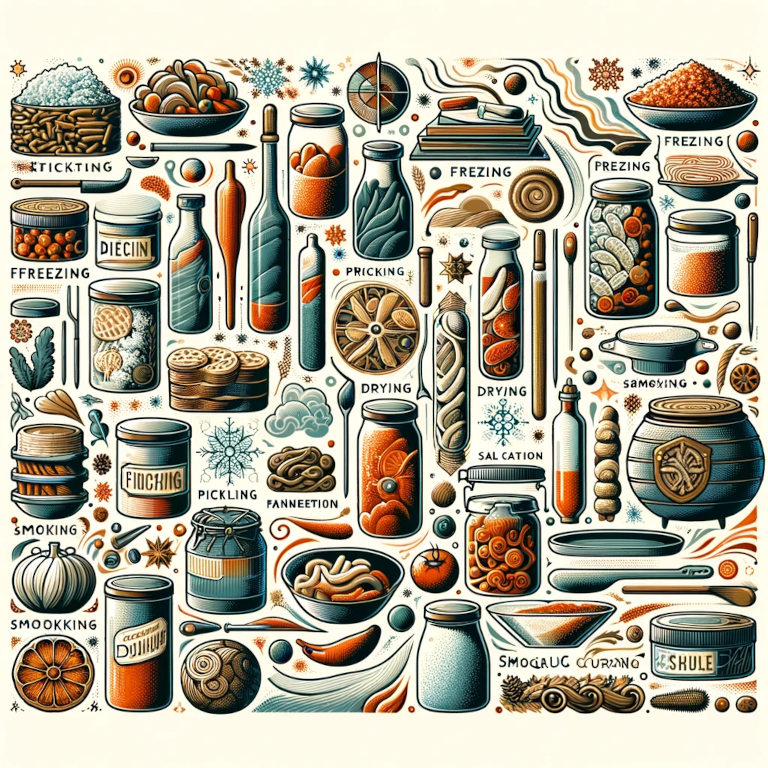In today’s fast-paced world, the ancient practices of food preservation have gained modern appeal, offering health benefits, sustainability, and a deep connection to culinary traditions. As an expert in Food and Cooking, I will guide you through various food preservation techniques that not only extend the shelf life of foods but also enhance flavors, making your meals both delicious and nutritious.
Understanding Food Preservation
Food preservation involves treating and handling food in a way that preserves its edibility and nutritional value. This can include processes to delay spoilage caused by bacteria, molds, fungi, or yeast, and in some cases, can extend the life of the food indefinitely.
Canning: Sealing the Freshness
Canning is a method that has been used for centuries, involving the process of packing foods into airtight containers, typically glass jars, and heating them to a temperature that destroys microorganisms that cause food to spoil. This method is perfect for fruits, vegetables, meats, and seafood. The high heat used in canning also seals the jars, ensuring no new bacteria can enter.
Freezing: Locking in Flavor and Nutrients
Freezing is perhaps the simplest food preservation method and one of the most effective at maintaining the quality of food. By freezing your favorite fruits, vegetables, meats, and even cooked dishes, you effectively pause the activity of microorganisms and enzymes that contribute to food spoilage. Proper packaging is crucial to avoid freezer burn and maintain the food’s quality.
Drying: A Tradition Revisited
Drying food is a preservation method that reduces the water content of your food, inhibiting the growth of microorganisms. Sun drying, air drying, or using a dehydrator are all methods that can be employed to dry foods like fruits, vegetables, and meats. This method not only preserves foods but also concentrates flavors, making them more potent and satisfying.
Pickling: Flavor and Health in Every Bite
Pickling goes beyond just cucumbers. This method uses vinegar or brine to create an acidic environment where bacteria cannot thrive. The high acidity also breaks down the food’s natural fibers, infusing it with flavor and creating a unique texture. Pickled foods are not just a great way to preserve seasonal produce but are also rich in beneficial probiotics.
Fermentation: The Power of Probiotics
Fermentation is a magical process where natural bacteria feed on the sugar and starch in the food creating lactic acid. This process not only preserves the food but also promotes the growth of beneficial bacteria which are good for the gut. Foods like yogurt, sauerkraut, kimchi, and kefir are all examples of fermented foods that are celebrated for their health benefits.
Salt Curing: From the Sea to Your Table
Salting is one of the oldest methods of food preservation. The salt draws out moisture and creates an environment inhospitable to microbial growth. Meats and fish are the most common candidates for salting, which not only preserves them but also imparts a unique flavor.
Smoking: Infusing Flavor and Longevity
Smoking involves exposing food to smoke from burning or smoldering material, usually wood. This technique does wonders for preserving meat and fish while adding a distinctive smoky flavor that is highly prized in many cuisines around the world.
Sugar Preservation: Sweet Simplicity
Preserving with sugar, whether in the form of jam, jelly, or candied fruit, draws out moisture from the food, thus inhibiting the growth of microorganisms. Sugar preservation is not only effective but also results in some of the most delicious treats.
Embracing Tradition for Future Sustainability
Each of these food preservation techniques offers a way to reduce food waste, lower grocery costs, and enjoy seasonal flavors all year round. By mastering these methods, you can ensure that your kitchen is always stocked with a diverse range of products, enhancing both your diet and your cooking.
Food preservation is an art that rewards the patient and the diligent. Whether you are a novice looking to experiment or a seasoned pro aiming to refine your craft, the world of food preservation is rich with flavors, textures, and nutrients, waiting to be explored.






